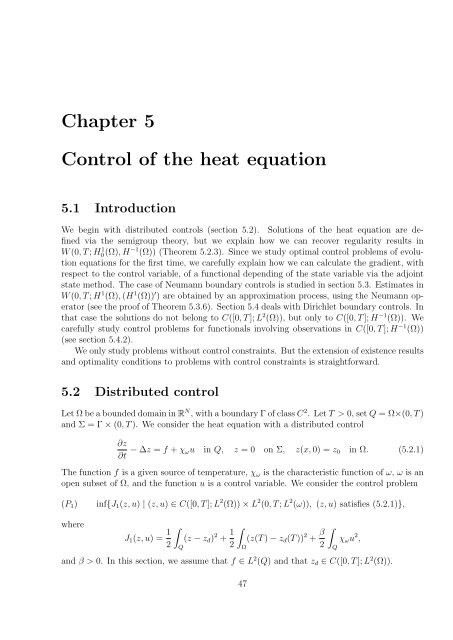Optimal Control of Partial Differential Equations
Optimal Control of Partial Differential Equations
Optimal Control of Partial Differential Equations
You also want an ePaper? Increase the reach of your titles
YUMPU automatically turns print PDFs into web optimized ePapers that Google loves.
Chapter 5<br />
<strong>Control</strong> <strong>of</strong> the heat equation<br />
5.1 Introduction<br />
We begin with distributed controls (section 5.2). Solutions <strong>of</strong> the heat equation are defined<br />
via the semigroup theory, but we explain how we can recover regularity results in<br />
W (0, T ; H 1 0(Ω), H −1 (Ω)) (Theorem 5.2.3). Since we study optimal control problems <strong>of</strong> evolution<br />
equations for the first time, we carefully explain how we can calculate the gradient, with<br />
respect to the control variable, <strong>of</strong> a functional depending <strong>of</strong> the state variable via the adjoint<br />
state method. The case <strong>of</strong> Neumann boundary controls is studied in section 5.3. Estimates in<br />
W (0, T ; H 1 (Ω), (H 1 (Ω)) ′ ) are obtained by an approximation process, using the Neumann operator<br />
(see the pro<strong>of</strong> <strong>of</strong> Theorem 5.3.6). Section 5.4 deals with Dirichlet boundary controls. In<br />
that case the solutions do not belong to C([0, T ]; L 2 (Ω)), but only to C([0, T ]; H −1 (Ω)). We<br />
carefully study control problems for functionals involving observations in C([0, T ]; H −1 (Ω))<br />
(see section 5.4.2).<br />
We only study problems without control constraints. But the extension <strong>of</strong> existence results<br />
and optimality conditions to problems with control constraints is straightforward.<br />
5.2 Distributed control<br />
Let Ω be a bounded domain in R N , with a boundary Γ <strong>of</strong> class C 2 . Let T > 0, set Q = Ω×(0, T )<br />
and Σ = Γ × (0, T ). We consider the heat equation with a distributed control<br />
∂z<br />
∂t − ∆z = f + χωu in Q, z = 0 on Σ, z(x, 0) = z0 in Ω. (5.2.1)<br />
The function f is a given source <strong>of</strong> temperature, χω is the characteristic function <strong>of</strong> ω, ω is an<br />
open subset <strong>of</strong> Ω, and the function u is a control variable. We consider the control problem<br />
(P1) inf{J1(z, u) | (z, u) ∈ C([0, T ]; L 2 (Ω)) × L 2 (0, T ; L 2 (ω)), (z, u) satisfies (5.2.1)},<br />
where<br />
J1(z, u) = 1<br />
<br />
(z − zd)<br />
2 Q<br />
2 + 1<br />
<br />
(z(T ) − zd(T ))<br />
2 Ω<br />
2 + β<br />
<br />
χωu<br />
2 Q<br />
2 ,<br />
and β > 0. In this section, we assume that f ∈ L 2 (Q) and that zd ∈ C([0, T ]; L 2 (Ω)).<br />
47

















